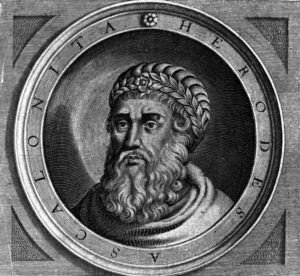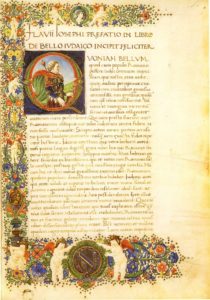Showing posts with label the Jews. Show all posts
Showing posts with label the Jews. Show all posts
Tuesday, July 14, 2020
Friday, June 26, 2020
Tuesday, June 23, 2020
Friday, July 27, 2018
In What Year Did Herod Die?
Luke was right after all.
by Ruggero Sangalli
One of the frequently quoted historical reference points for chronologicalizing the events reported in the Gospel concerns the year of the death of King Herod the Great: the year 4 BC, at least according to many authors.

This year we owe to the writings of Flavius Josephus, who, however, never expressly names them. It is derived from the reigns of Archelaus, Philippos and Antipas, the heirs of Herod. But Flavius Josephus himself provides at least a dozen clues that contradict and render the year useless as Herod's year of death. For example, it was not uncommon to reckon with the successor's reigning years as well as the time when the office was held, but the old king was still alive.
Amazingly, many writers today write that "Herod certainly died in the year 4 BC." They do so with such confidence in Flavius Josephus that they simply ignore many other of his statements, which are much more precise. Flavius Josephus wrote that Herod died at the age of seventy. Similarly, at the age of just 15, Herod was appointed by his father Antipater to be the administrator of Galilee, after he had come to power from Pompey, after the Romans conquered Jerusalem in 63 BC.
We also know that at the time of the Battle of Actium, in September 31 BC, Herod was in the seventh year of his kingship. According to Jewish Antiquities, his reign lasted 37 years, 30 to 31 years after the Battle of Actium. We know that Herod, in the eighteenth year of his reign, after the visit of Emperor Augustus to Syria, for which the Roman historians handed down to us the year 19 BC, resolved to rebuild the temple (the 15th year of his reign, according to the records) in the History of the Jewish War , in which Herod's reign is given as 34 years). In short, in the year 4 BC, Herod was still alive.
Astronomy gives justice to the Evangelist Luke
Astronomy is also in this case an effective tool for determining the timing of historical events. It provides both Flavius Josephus as a historian, and Luke as an evangelist justice, but to the detriment of many modern authors. Flavius Josephus wrote that Herod died about two weeks after a spectacular lunar eclipse and that his funeral took place before the subsequent Jewish Passover. The records of NASA allow us to calculate the exact date of the lunar eclipses of that time and eliminate those that were invisible in Palestine.
Those who insist that Herod died in the year 4 BC look at the darkness of March 13 (according to the Julian calendar) of that year. At that time the 14th Nisan fell on the 12th of April, so 29 days later. After all, however, what Flavius Josephus reports for that period, the time span is too short to be that date. An often overlooked detail: the 13th of March would have been the 14th Adar, a feast day (Purim) associated with the 13th Adar, the day of Nicanor, a feast day since the times of the Maccabees.
Flavius Josephus testifies that just a few days before, two rabbis had instigated an anti-Roman uprising, destroying the gilded eagle that Herod had placed on the outside of the Jerusalem temple. For security reasons, Herodes preferred to bring the two rabbis outside Jericho to Jerusalem, where he was in the spa to heal his physical ailments. He had them burned alive on the very day of darkness ( Jewish Antiquities , chapter XXVII).

Considering the great respect of the Jews for holy days, which Herod always kept disparaging, but no court could have been found, not even an unlawful one, to pass a verdict on a religious feast (Est 9,17--18), let alone against two well-known rabbis. The entire population would have been scandalized about it. However, Flavius Josephus reported that it was not just any court, but the Highest Court of the Jews, the right-wingers par excellence. He also recalled that Archelaos (co-regent of Antipas and Philippos since the year 4 BC), because of the persistent criticism of the judgment, expressly justified that it was done "in accordance with the law." Even with Jesus, the "law" endeavored to accelerate his execution so that no feast day would be profaned.
The 14th Adar may not have been the date of the lunar eclipse and therefore it is not the year 4 BC that interests us. Herod, an Idumaean, would not have had two rabbis burned on a day when Haman was burned according to the ancient tradition of the Purim festival.
If there are any doubts: Flavius Josephus lists for the period after this "impossible execution" and before the Passover, a series of events that occurred before Herod's death (which occurred about two weeks after the lunar eclipse). However, the dates are incompatible with the few missing days until the 14th Nisan.
So it must have been another lunar eclipse. According to NASA directory, two especially would be in question. The first occurred on the 10th of January of the year 1 before Christ, the second on the 29th of December of the same year. In both cases there would be sufficient time to accommodate all the events that Flavius Josephus mentions between the darkness and the subsequent Passover. A Jewish document, Megillat Taanith, which dates back to the destruction of the temple in the year 70 AD, has been handed down to us. The scrolls contain a list of Jewish festivals. In it are two dates without further information, on which it was forbidden not to celebrate: one is the 7th Kislev, the other of the 2 Shevat.
M. Moise Schwab, through a detailed and intricate study in the 2nd Shevat, pinpointed the death of Herod, exactly two weeks after the lunar eclipse of December 29, the 14th of January of the year 1 AD, according to today's calendar. The lunar eclipse came exactly at dusk, so that everyone could see it. Herod, born 70 BC, ruler since the year 37 BC, was 70 years old, and had ruled 37 years according to the specifications of the Jewish Antiquities. Jesus was born about a year before, at the end of the year 2 BC. Everything fits, at least for those who are willing to take a close look.
Text: Ruggero Sangalli / NBQ
Translation: Giuseppe Nardi
Pictures: Wikicommons
Translation: Giuseppe Nardi
Pictures: Wikicommons
Trans: Tancred vekron99@hotmail.com
AMDG
Friday, December 26, 2014
Feast of St. Stephen, Protomartyr
 |
| Take Note of St. Stephen's Liturgical Rainment |
The conflict broke out when the cavillers of the synagogues "of the Libertines, and of the Cyreneans, and of theAlexandrians, and of them that were of Cilicia and Asia", who had challenged Stephen to a dispute, came out completely discomfited (vi, 9 10); wounded pride so inflamed their hatred that they suborned false witnesses to testify that "they had heard him speak words of blasphemy against Moses and against God" (vi, 11).
No charge could be more apt to rouse the mob; the anger of the ancients and the scribes had been already kindled from the first reports of the preaching of the Apostles. Stephen was arrested, not without some violence it seems (the Greek word synerpasan implies so much), and dragged before the Sanhedrin, where he was accused of saying that "Jesus of Nazareth shall destroy this place [the temple], and shall change the traditions which Moses delivered unto us" (vi, 12 14). No doubt Stephen had by his language given some grounds for the accusation; his accusers apparently twisted into the offensive utterance attributed to him a declaration that "the most High dwelleth not in houses made by hands" (vii, 48), some mention of Jesus foretelling the destruction of the Temple and some inveighing against the burthensometraditions fencing about the Law, or rather the asseveration so often repeated by the Apostles that "there is no salvationin any other" (cf. iv, 12) the Law not excluded but Jesus. However this may be, the accusation left him unperturbed and "all that sat in the council...saw his face as if it had been the face of an angel" (vi, 15).
Stephen's answer (Acts 7) was a long recital of the mercies of God towards Israel during its long history and of the ungratefulness by which, throughout, Israel repaid these mercies. This discourse contained many things unpleasant toJewish ears; but the concluding indictment for having betrayed and murdered the Just One whose coming the Prophetshad foretold, provoked the rage of an audience made up not of judges, but of foes. When Stephen "looking up steadfastly to heaven, saw the glory of God, and Jesus standing on the right hand of God", and said: "Behold, I see the heavens opened, and the Son of man standing on the right hand of God" (vii, 55), they ran violently upon him (vii, 56) and cast him out of the city to stone him to death. Stephen's stoning does not appear in the narrative of the Acts as adeed of mob violence; it must have been looked upon by those who took part in it as the carrying out of the law. According to law (Leviticus 24:14), or at least its usual interpretation, Stephen had been taken out of the city; customrequired that the person to be stoned be placed on an elevation from whence with his hands bound he was to be thrown down. It was most likely while these preparations were going on that, "falling on his knees, he cried with a loud voice, saying: "Lord, lay not this sin to their charge" (vii, 59). Meanwhile the witnesses, whose hands must be first on theperson condemned by their testimony (Deuteronomy 17:7), were laying down their garments at the feet of Saul, that they might be more ready for the task devolved upon them (vii, 57). The praying martyr was thrown down; and while the witnesses were thrusting upon him "a stone as much as two men could carry", he was heard to utter this supremeprayer: "Lord Jesus, receive my spirit" (vii, 58). Little did all the people present, casting stones upon him, realize that the blood they shed was the first seed of a harvest that was to cover the world.
The bodies of men stoned to death were to be buried in a place appointed by the Sanhedrin. Whether in this instance the Sanhedrin insisted on its right cannot be affirmed; at any rate, "devout men" — whether Christians or Jews, we are not told — "took order for Stephen's funeral, and made great mourning over him" (vii, 2). For centuries the location of St. Stephen's tomb was lost sight of, until (415) a certain priest named Lucian learned by revelation that the sacred body was in Caphar Gamala, some distance to the north of Jerusalem. The relics were then exhumed and carried first to thechurch of Mount Sion, then, in 460, to the basilica erected by Eudocia outside the Damascus Gate, on the spot where, according to tradition, the stoning had taken place (the opinion that the scene of St. Stephen's martyrdom was east ofJerusalem, near the Gate called since St. Stephen's Gate, is unheard of until the twelfth century). The site of the Eudocian basilica was identified some twenty years ago, and a new edifice has been erected on the old foundations by the Dominican Fathers.
Subscribe to:
Posts (Atom)
